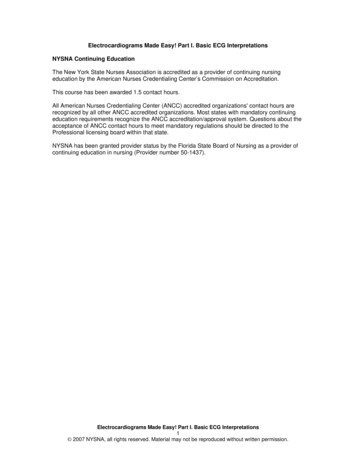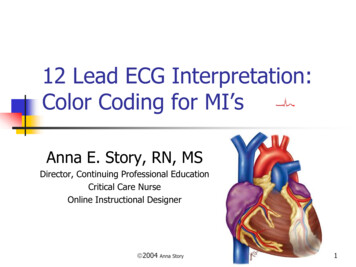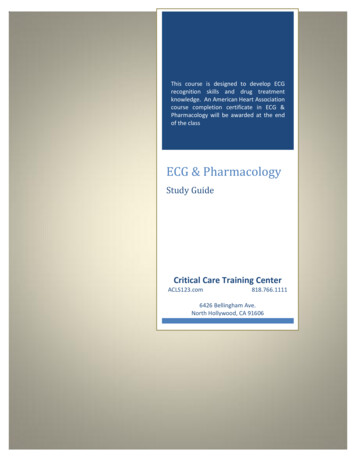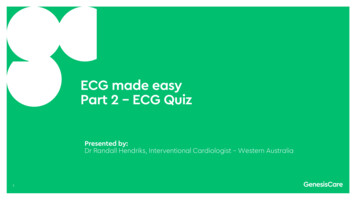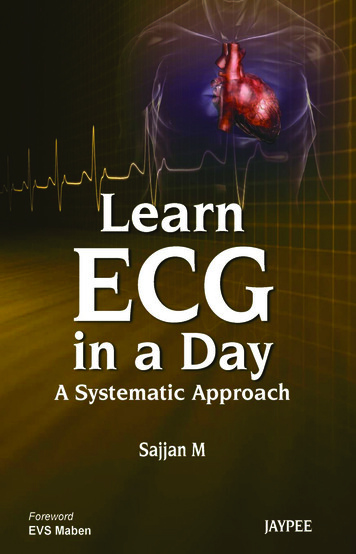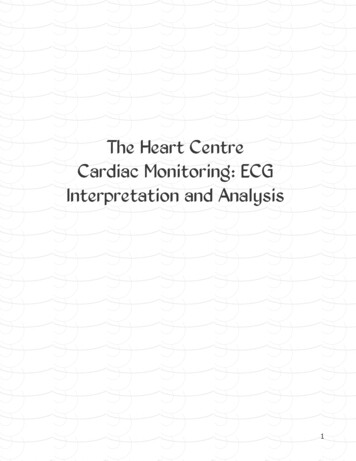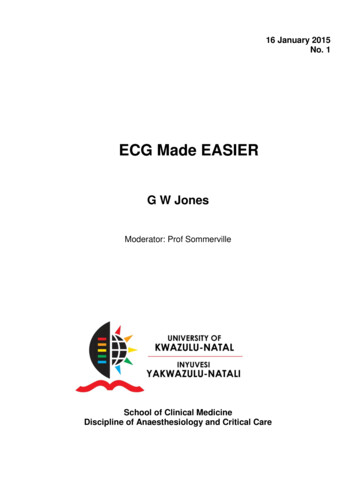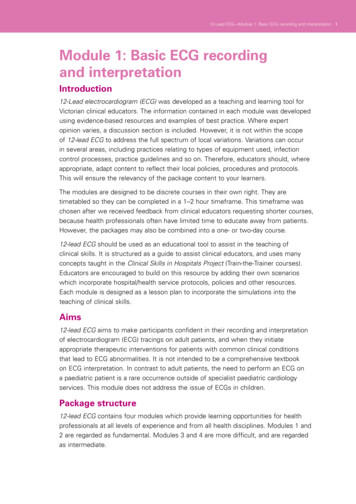
Transcription
12-Lead ECG—Module 1: Basic ECG recording and interpretation 1Module 1: Basic ECG recordingand interpretationIntroduction12-Lead electrocardiogram (ECG) was developed as a teaching and learning tool forVictorian clinical educators. The information contained in each module was developedusing evidence-based resources and examples of best practice. Where expertopinion varies, a discussion section is included. However, it is not within the scopeof 12-lead ECG to address the full spectrum of local variations. Variations can occurin several areas, including practices relating to types of equipment used, infectioncontrol processes, practice guidelines and so on. Therefore, educators should, whereappropriate, adapt content to reflect their local policies, procedures and protocols.This will ensure the relevancy of the package content to your learners.The modules are designed to be discrete courses in their own right. They aretimetabled so they can be completed in a 1–2 hour timeframe. This timeframe waschosen after we received feedback from clinical educators requesting shorter courses,because health professionals often have limited time to educate away from patients.However, the packages may also be combined into a one- or two-day course.12-lead ECG should be used as an educational tool to assist in the teaching ofclinical skills. It is structured as a guide to assist clinical educators, and uses manyconcepts taught in the Clinical Skills in Hospitals Project (Train-the-Trainer courses).Educators are encouraged to build on this resource by adding their own scenarioswhich incorporate hospital/health service protocols, policies and other resources.Each module is designed as a lesson plan to incorporate the simulations into theteaching of clinical skills.Aims12-lead ECG aims to make participants confident in their recording and interpretationof electrocardiogram (ECG) tracings on adult patients, and when they initiateappropriate therapeutic interventions for patients with common clinical conditionsthat lead to ECG abnormalities. It is not intended to be a comprehensive textbookon ECG interpretation. In contrast to adult patients, the need to perform an ECG ona paediatric patient is a rare occurrence outside of specialist paediatric cardiologyservices. This module does not address the issue of ECGs in children.Package structure12-lead ECG contains four modules which provide learning opportunities for healthprofessionals at all levels of experience and from all health disciplines. Modules 1 and2 are regarded as fundamental. Modules 3 and 4 are more difficult, and are regardedas intermediate.
212-Lead ECG—Module 1: Basic ECG recording and interpretationLevel of complexityComplexFor participants withmore than 4 yearsexperience or whohave completedModules 1–4IntermediateFor participants inpostgraduate years3–4 or who havecompleted Modules1 and 2Package structureManagement ofarrhythmiasManagement of acutecoronary syndromeBasic ECG recordingand interpretationAbnormal ECGsFundamentalFor participantsin postgraduateyears 1–212-lead ECG was designed to develop participants’ knowledge, skills and behavioursin ECG interpretation, and to expose them to increasingly complex scenarios aimed attesting their ability to combine these skills, work as a team and problem solve in moredifficult situations.Educators delivering these modules should be aware of participants’ level ofexperience and choose appropriate modules. Modules presume an increasing levelof knowledge as they progress, ranging from a fundamental knowledge of anatomyand physiology for the fundamental modules, up to detailed knowledge of arrhythmiaand acute coronary syndrome management for the more complex modules.Novice participants (such as first-year graduates) are expected to start with thefundamental modules, and only move onto intermediate and more complex modulesas they demonstrate proficiency. More experienced participants may start at theintermediate level if the educator is satisfied that they have the prior knowledge andskills. Individual educators are responsible for assessing each participant’s baselineknowledge and determining which modules they need to complete. While theintermediate modules contain considerable medical detail, non-medical participantscan still gain valuable experience from these modules by focusing on their roles andexpectations in these scenarios. If the group contains no medical staff, facilitatorsmay need to play the medical roles. More specific descriptions of presumedknowledge are outlined in each module.
12-Lead ECG—Module 1: Basic ECG recording and interpretation 3The design of these packages presumes that the clinical educators using them haveknowledge and expertise in current best practice regarding the teaching of clinicalskills and conducting facilitated discussions. Knowledge and expertise are presumedcommensurate with the Department of Human Services’ basic and advancedTrain-the-Trainer Programs. Clinical educators are encouraged to refer to Departmentof Human Services’ Clinical Skills Facilitators Manual for theory on:1. Peyton’s model for teaching clinical skills2. leading small group discussions3. giving feedback4. crisis resource management skills.
12-Lead ECG—Module 1: Basic ECG recording and interpretation 5Module 1: Basic ECG recordingand interpretationAuthors: Dr Stuart Dilley, Ms Debbie PaltridgeAimsThe purpose of 12-lead ECG—Module 1: Basic ECG recording and interpretation isto teach, and/or consolidate participants’ knowledge of, clinical skills required foracquiring and interpreting a normal electrocardiogram (ECG).Presumed knowledgeThis module is targeted to health professionals with little or no experience in ECGacquisition and interpretation. However, they are expected to have a basic knowledge of:1. cardiac anatomy: cardiac chambers2. cardiac electrophysiology: conduction system3. basic principles of the 12-lead ECG.ObjectivesBy the end of this module, participants should have:1. reviewed the electrophysiology of the heart as it relates to the ECG2. identified the characteristics of a normal ECG3. practised recording an ECG using an appropriate human volunteer4. practised interpreting and communicating the appearance of normal ECGs5. identified common errors in ECG recording.Background information for educatorsAn electrocardiogram (ECG) is the graphical record produced by an electrocardiograph,a machine that records the electrical activity of the heart over time. The ECG allowshealth professionals to diagnose and monitor various cardiac conditions, includingarrhythmias (irregularities of cardiac rhythm) and myocardial damage (such asmyocardial infarction).ElectrophysiologyThe contraction of any muscle, including the heart, is associated with electricalchanges called ‘depolarisation’. The electrical discharge for the normal heart usuallyfollows a standard pathway1, 2:1. Electrical discharge starts in the right atrium at the sino-atrial (SA) node, the heart’s‘natural pacemaker’. The SA node discharges 60–80 times per minute, resulting ina heart rate of 60–80 beats per minute (bpm).2. Depolarisation spreads throughout the atrial muscle fibres.
612-Lead ECG—Module 1: Basic ECG recording and interpretation3. The wave of depolarisation reaches the atrio-ventricular (AV) node, where itsconduction to the ventricles is briefly delayed.4. Conduction then occurs rapidly down the ‘bundle of His’ and its two branches,the left and right bundle branches. The left bundle further divides into anterior andposterior fascicles.5. Conduction then occurs more slowly through specialised Purkinje fibres, resultingin ventricular muscle depolarisation.6. Atrial repolarisation (return to resting electrical status) occurs during ventriculardepolarisation.7. Ventricular repolarisation occurs following ventricular depolarisation and before thenext SA discharge.Abnormalities in this conduction system may occur with cardiac disease, and aresubsequently reflected in the ECG pattern. Indications for performing an ECG include:1. irregular heart rate or palpitations2. chest pain3. fast heart rates ( 100 bpm)4. slow heart rates ( 50 bpm)5. collapse or syncope (collapse with spontaneous return of consciousness)6. chest trauma where cardiac injury is suspected, for example, blunt trauma to thechest (as might occur when a pedestrian is struck by car)7. pre-operative assessment of at-risk patients, for example, the elderly.Normal ECGAll ECG machines run at a standard rate (25 mm per second) and use paper withstandard-sized squares. Each small square (1 mm) represents 40 ms (0.04 seconds),while each large square (5 mm) represents 200 ms (0.2 seconds). On the y axis, eachsmall square represents 0.1 mV.ECGs may be recorded as a standard ‘12-lead ECG’, individual ‘rhythm strips’ or asspecialised ECGs that look at different parts of the heart. In all cases, a standard ECGcomplex is produced, which consists of:1. A P wave, representing atrial depolarisation. The presence of P waves indicates‘sinus rhythm’, the heart’s normal rhythm.2. A PR interval, representing conduction through the AV node and the bundle of His.This should be between 120–200 ms, or less than 5 mm on the ECG paper.
12-Lead ECG—Module 1: Basic ECG recording and interpretation 73. The QRS complex, representing depolarisation of the ventricles. A Q wave is anynegative deflection at the beginning of a QRS complex. Small Q waves in someleads may be normal. Large Q waves ( 2 mm) may be abnormal. An R wave isthe first positive deflection, and an S wave is the negative deflection immediatelyfollowing an R wave. The QRS complex should be less than 120 ms (3 mm).4. The ST segment, between the end of the S wave and start of the T wave. The STsegment should be ‘isoelectric’, that is, at the same level as the part between theT wave and the next P wave.5. A T wave, representing repolarisation of the ventricles.Figure: QRSFigure 1: QRSA standard 12-lead ECG records these PQRST complexes in real time from differentlocations around the heart. Hence, every lead appears slightly different, while stillcontaining a PQRST complex.Of the 12 leads, six are referred to as ‘limb leads’. The limb leads are leads I, II, III,aVR, aVL and aVF. The other six are referred to as ‘chest’ or ‘precordial’ leads. Theseleads are V1, V2, V3, V4, V5 and V6.The limb leads record the electrical activity in the heart in the vertical plane. The chestleads record the electrical activity of the heart in the horizontal plane. Thus, differentleads can be grouped together when looking for consistency of ECG appearances(normal or abnormal) for different parts of the heart.Figure 2: ECG appearances for different parts of the heart*Chest leads V1–V6 are projected anteriorly out of the diagram fromV1 at the right to V6 at the left of the heart.
812-Lead ECG—Module 1: Basic ECG recording and interpretation1. inferior surface: II, III, aVF2. left lateral surface: I, II, aVL3. right lateral surface: aVR, V1, V24. anterior and septal: V3, V45. anterior and lateral: V5, V6.The wave of depolarisation (‘axis’) travels from the upper right to the lower left ofthe heart. As depolarisation travels towards an ECG electrode, the ECG records anupward deflection. Conversely, depolarisation spreading away from the electroderecords a downward deflection. In most leads, the P waves and T waves are positivedeflections (apart from aVR), and the QRS complexes are predominantly positive(apart from aVR, and sometimes V1, V2 and lead III).Figure 3: Wave of depolarisationECG recordingObtaining an ECG from a patient is a relatively simple procedure. However,practitioners must follow all steps and take all possible measures to avoid errorand minimise interference and artefact. This should include these steps:1. Confirm the identity of the patient requiring an ECG.2. Explain the procedure to the patient.3. Offer the patient privacy.4. Remove the patient’s clothing to allow ECG recording while minimising exposureand maintaining warmth.5. Position the patient in the supine position if possible. Patients with severerespiratory compromise will not be able to lie in this position and may need tohave an ECG performed while sitting or semi-recumbent.
12-Lead ECG—Module 1: Basic ECG recording and interpretation 96. Place the ECG electrodes (‘dots’ or ‘tabs’) in the correct position on the patient’schest and limbs (see below). This may require removal of body hair or drying ofthe skin.7. Connect the labelled ECG leads to their corresponding electrodes.8. Turn on the ECG machine.9. Press the ‘filter’ switch to ‘on’.10. Enter patient details.11. Advise the patient to relax and lie still.12. Press the appropriate button on the machine to initiate recording, usually‘start’ or ‘auto’.13. Review the printed ECG to confirm adequacy of the tracing and to identifyimmediate life-threatening abnormalities (see below, under ‘Checking the ECG’).14. If the ECG machine does not allow direct entry of patient details, these should beattached to the ECG as soon as the tracing is recorded.The modern, standard 12-lead ECG requires that 10 ECG leads be attached to thepatient’s body. The leads are labelled to assist correct placement. These leads mustbe placed correctly to avoid obtaining a misleading ECG. The ECG leads should beplaced as follows3, 4:1. LL: left leg, distally2. RL: right leg, distally3. LA: left arm, distally4. RA: right arm, distally5. V1: fourth intercostal space, to the right of the sternum6. V2: fourth intercostal space, to the left of the sternum7. V3: midway between V2 and V48. V4: fifth left intercostal space, mid-clavicular line9. V5: at the horizontal level of V4, anterior axillary line (or midway between V4 andV6 if the anterior axillary line is not well defined)10. V6: at the horizontal level of V4 and V5, mid-axillary line.
1012-Lead ECG—Module 1: Basic ECG recording and interpretationFigure 4: 12-lead ECGAccurately locating the fourth intercostal space is important. One of the mostcommon errors in recording an ECG is to place V1 and V2 too high, resulting in all Vleads positioned at a higher level on the chest. The fourth intercostal space is foundby undertaking these steps:1. Identify the sternal angle or ‘angle of Louis’ (the angle between the upper part ofthe sternum and the body of the sternum), where the manubrium meets the bodyof the sternum. Run your finger down the sternum from the sternal notch at thetop, until you meet a bony horizontal ridge. This is the sternal angle.2. From this ridge, slide your finger down and to the side to locate the secondintercostal space.3. Count down from this space to identify the third and fourth intercostal spaces.When recording an ECG from female patients, the convention is to place the lateralchest leads (V4, 5 and 6) beneath the breast, rather than over it5.Checking the ECGThe ECG potentially contains a lot of information. Checking the ECG andcommunicating its findings requires a systematic approach. The following featuresshould be observed and described:1. Cardiac rate: this can be estimated by dividing 300 by the number of largesquares between QRS complexes.2. Underlying cardiac rhythm: the presence of P waves indicates normal sinusrhythm. Each P wave should be followed by a QRS complex. Sinus rhythm shouldbe regular.3. PR interval: this should normally be less than 200 ms (5 mm), and indicatesnormal conduction through the AV node.
12-Lead ECG—Module 1: Basic ECG recording and interpretation 114. A description of the QRS complexes: this should normally be less than120 ms (3 mm), and indicates normal conduction through the bundle of Hisand bundle branches.5. A description of the ST segment and T waves: the ST segment should be‘isoelectric’ (that is, at the baseline), and T waves should be upright in most leads(except for aVR and occasionally V1, III).Common ECG abnormalities that should be identified immediately and warrantreferrals to an experienced ECG interpreter include:1. heart rhythms that are irregular2. absence of P waves3. fast heart rates ( 100 bpm)4. slow ( 50 bpm) heart rates5. wide QRS complexes ( 120 ms, or 3 mm)6. ST segments that are either elevated or depressed—that is, not isoelectric7. T wave inversion (apart from isolated T wave inversion in aVR).Common problemsAn underappreciated cause of ECG abnormality is electrode disconnection,misplacement, misconnection and artefact. ECGs recorded in these instances shouldbe recognised and discarded, and a correctly recorded ECG obtained immediately.Leads may be correctly placed initially, but then become disconnected. This isreflected as one straight line in the case of a chest lead (V lead) disconnection, andstraight lines in all leads in the case of a limb lead disconnection.Figure 5: V3 disconnected
1212-Lead ECG—Module 1: Basic ECG recording and interpretationFigure 6: 12-lead ECG with left arm lead disconnected (no leads are seen by ECG machine)Leads may be misplaced if care is not taken to identify the sternal angle, secondand subsequent intercostal spaces and mid-clavicular and axillary lines for placementof chest leads. Misplacement of the chest leads may result in QRS and T waveabnormalities.Limb electrode reversal is a common error6, and includes RA/LA, RL/LL, RA/RL andLA/LL reversal. RA/LL and LA/RL reversal is less common. Arm electrode (RA/LA)reversal is the commonest error, but fortunately, is easy to detect on ECG. Lead I isessentially reversed in this instance, resulting in negative (inverted) P waves, QRScomplex and T wave in lead I and aVL. Conversely, aVR displays positive deflectionsfor these waves and complexes, rather than the normal negative deflections inthis lead.Reversal of leg electrodes (RL/LL) causes no discernible difference in ECGappearances, because the RL electrode merely serves as a ground electrode, andthere is no potential difference between the two leg electrodes. However, RLelectrode reversal with either arm electrode (RA/RL or RL/LA) results in a relatively flatline (or reduced amplitude) in one of the limb leads (lead II if RL/RA reversal, lead III ifRL/LA reversal). Lead III will also appear inverted.Left-sided electrode reversal (LA/LL) is the most difficult to detect, and may appearnormal until compared with previous ECGs for that patient. However, two inferiorleads (II, aVF) become lateral (I, aVL) and vice versa.
12-Lead ECG—Module 1: Basic ECG recording and interpretation 13Figure 7: RA/LA reversalFigure 8: RA/RL reversalFigure 9: LA/LL reversal
1412-Lead ECG—Module 1: Basic ECG recording and interpretationChest leads may also be misconnected, but these are usually easily detected by aninterruption to the usual R wave growth and S wave regression from V1 to V6.ECG artefact is usually easily recognised, and may be produced by patient movement(tremor, rigors, restlessness, seizures) or electrical interference. ECGs should beperformed in a warm environment with the patient still, with good electrode contactwith the skin and away from interfering electrical devices.Figure 10: Artefact in leads due to patient tremorLearning activitiesSuggested learning activities and timetable are outlined below.TimingActivityObjective40 minutesFacilitated discussion1, 2, 4, 560 minutesSkills stations:3, 4, 5 ECG recording ECG interpretation10 minutesSummary10 minutesEvaluationAllTotal time 2 hoursFacilitated discussionThe facilitator should lead a discussion amongst participants about the issues coveredin the background information, for example, cardiac conduction and electrophysiologyand normal ECG interpretation. The facilitator should not give a didactic lecture,but instead promote open discussion and knowledge sharing amongst participants.
12-Lead ECG—Module 1: Basic ECG recording and interpretation 15Participants should be encouraged to describe any real-life experiences they haveencountered.The facilitator should ensure these major issues are covered: indications for ECG recording relationship between ECG waves and cardiac electrophysiology correct procedure for recording an ECG techniques for describing ECG findings common errors in ECG recording.PowerPoint slides are available for the facilitator to use to summarise these mainpoints at the end of the discussion, or as triggers if participants have not identified themajor issues.Skills stationsThe skills stations allow participants to practise recording, interpreting andcommunicating the appearance of normal ECGs using appropriate models, whilereceiving feedback in a structured format from peers and/or facilitators.The program and resources required assume two facilitators for every eightparticipants, a ratio of 1:4. Four participants start at each of the two stations andchange over after 30 minutes.1. ECG recordingParticipants should be guided through the recording of an ECG using Peyton’s fourstep model7. Feedback should be provided at the completion of the skill.For this station, it is important that participants actually practise locating intercostalspaces, attach ECG leads and record an ECG. Few manikins or simulation modelshave enough fidelity to provide this experience adequately. Some models allow12-lead ECGs to be recorded, but do not allow for accurate assessment of leadpositioning. Therefore ‘live models’ should be used. These may be participantvolunteers, other faculty or other volunteers as available. Thus, participants canactually locate the sternal angle and associated intercostal spaces before applyingelectrodes and recording an ECG. This also allows the facilitator to demonstratechanges that might appear in the ECG tracing, should electrodes be misplaced.During these exercises, previously unrecognised ECG abnormalities might be foundwhen using volunteers. Facilitators should ensure that a process is in place at theirparticular institution to review these ECGs and make appropriate referrals to therelevant medical specialist if required. This process should be clearly outlined tovolunteers when they are recruited.
1612-Lead ECG—Module 1: Basic ECG recording and interpretationEach participant should have approximately seven minutes of hands-on experiencein correctly obtaining an ECG and confirming that it is acceptable as a tracingand normal.2. ECG interpretationThis station allows participants to review a series of ECGs and verbalise the findingsaccording to the standard procedure described. The module includes a series ofECGs on which to practise, but facilitators may like to use real ‘patients’ (volunteers),as for the ECG recording skills station. In this station, leads can be deliberatelydisconnected, misconnected or misplaced to demonstrate the changes that result.The following ECG examples are provided with this module:1. normal ECG ‘A’2. normal ECG ‘B’3. mislabelled ECG4. disconnected V-lead ECG5. disconnected limb lead ECG6. misconnection (RA/LA reversal) ECG7. misconnection (RA/RL reversal) ECG8. misconnection (LA/LL reversal) ECG9. tremor artefact ECG.Note: ECG 1 and 4–9 are from the same person and recorded all at the same time.Instruct participants of Group B that they can compare ECGs 4–9 with 1 to determinefindings.Each participant should have the opportunity to describe the findings of at least oneECG, and as a group, discuss the ECG appearances that indicate that an error inrecording has occurred.SummaryThe summary session reinforces content covered in the learning activities, and is anopportunity for participants to reflect on what they have covered. No new materialshould be introduced.Major points to recap in the summary include: the normal cardiac conduction system indications for ECG recording the importance of following procedure when recording the ECG the appearances of a normal ECG common errors encountered in ECG recording.
12-Lead ECG—Module 1: Basic ECG recording and interpretation 17Participants should be encouraged to read from the reference list to consolidate theirunderstanding of ECG principles and interpretation. While some health professionalsmay need to complete official hospital credentialling processes before performingthese skills in their workplace, participants should be encouraged to assist others inrecording and assessing ECGs as a lead-up to that process.Resource listThe following resource list assumes two facilitators for every eight participants, a ratioof 1:4. As a minimum, the following resources are needed to conduct this module.ResourceQuantityAdditional commentsPowerPoint presentation1Provided with module12-lead ECG machine1Including paperECG electrodes10Volunteer chest1–2At least one for ECG recording station,preferably a second for the ECGinterpretation stationECG sample set1 setFor use in ECG interpretation stationEvaluation sheets8One for each participantAlcohol swabs1 packet
1812-Lead ECG—Module 1: Basic ECG recording and interpretationEvaluationA formal evaluation has been specifically developed for this module. It incorporatesthe objectives of the module and the perceptions of the participants about whetherthey have increased their understanding by working through the module. It is highlyrecommended that this formal evaluation be copied and completed by all participantsat the completion of the module.A range of informal evaluation tools may also be used in conjunction with this evaluationthroughout the module, including those available in the Department of Human Services’Clinical Skills Facilitators Manual from the basic course conducted in 2007.References1. Hampton J. 2003 The ECG made easy (6th ed.) Churchill Livingstone, Edinburgh2. Hampton J. 2003 The ECG in practice (4th ed.) Churchill Livingstone, Edinburgh3. Kligfield P., Gettes L., Bailey J. et al. 2007 Recommendations for the standardizationand interpretation of the electrocardiogram: Part I: the electrocardiogram and itstechnology. Circulation 2007, 115: 1306–13244. Lee Garvey J. 2006 ECG techniques and technologies. Emerg Med Clin Nth Amer,24: 209–2255. Clinical guidelines by consensus 2006 Recording a standard 12-leadelectrocardiogram: An approved methodology. The Society for Cardiological Scienceand Technology, October 20066. Harrigan R. 2006 Electrode misconnection, misplacement and artefact. Emerg MedClin N Am, 24: 227–2357. Peyton J. 1998 Teaching and Learning in Medical Practice. Manticore Europe Ltd,Great Britain
12-Lead ECG—Module 1: Basic ECG recording and interpretation 19ResourcesFacilitator feedback formThe following form should be used to assist you in giving feedback after eachparticipant has practised their ECG skills at the skill station.Feedback using the Pendleton modelPendleton’s model of feedback assists learners to maximize their potential at differentstages of training, raise their awareness of strengths and areas for improvement, andidentify actions to be taken to improve performance. Pendleton’s rules are structuredin such a way that the learner identifies the positives first, in order to create a safeenvironment. This is followed by the facilitator or group reinforcing these positivesand discussing skills to achieve them. Different techniques are then suggested. Theadvantage of this method is that the learner’s strengths are discussed first. Avoidinga discussion of weaknesses right at the beginning prevents defensiveness and allowsreflective behaviour in the learner.Below is a series of questions to assist you in this technique:1. Ask the learner how they feel.2. Ask the learner what went well and why (this can be combinedwith question 1 and 3).3. Tell the learner what went well and why.4. Ask the learner what could have been done better and why.5. Tell the learner what could have been done better and why.6. Summarise the learner’s strengths and identify up to three things to concentrate on.Note: This form does not need to be given to the participant — it is a guide for you,the group facilitator.
12-Lead ECG—Module 1: Basic ECG recording and interpretationModule 1: Basic ECG recording and interpretation—evaluationThank you for participating in this module. As part of our commitment to qualityimprovement the following questionnaire will be used to plan future implementationof this module. We appreciate your time completing this evaluation.1. OverallHow would you rate this module?poorfairgoodvery goodoutstanding2. Learning objectivesReviewed the electrophysiology of the heart asit relates to the ECGIdentified the characteristics of a normal ECGPractised recording an ECG using anappropriate human volunteerPractised interpreting and communicating theappearance of normal ECGsIdentified common errors in ECG recordingReviewed the electrophysiology of the heart asit relates to the ECG3. Important learning outcomesWhat are the three most important things you have learned from this module?StronglyagreeAgreeLearning objectives of Module 1: Basic ECGrecording and interpretationSlightlyagree12-lead ECGDisagreePlease consider whether this module was successful in meeting the followinglearning objectives:Stronglydisagree20
12-Lead ECG—Module 1: Basic ECG recording and interpretation 214. Module reeStronglydisagreePlease indicate to what extent you agree or disagree with each of the followingstatements in relation to the implementation of the module.The facilitator respected my experienceThe facilitator encouraged my participationI was able to ask the facilitator questionsThe facilitator was able to answer myquestionsThe feedback I received was clearThe feedback I received will assist me in myfuture performanceThere was adequate time for the skills stationsThere was adequate time for the facilitateddiscussionsThere was adequate time for the simulationsI have increased my confidence in performing a12-lead ECGI have identified future learning needs in thistopic area5. Future module implementationDo you think the module should be altered in any way?yesnoIf yes, what recommendations do you have?Thank you
2
Module 1: Basic ECG recording and interpretation Introduction 12-Lead electrocardiogram (ECG) was developed as a teaching and learning tool for Victorian clinical educators. The information contained in each module was developed using evidence-based resources and examples of best practice.

